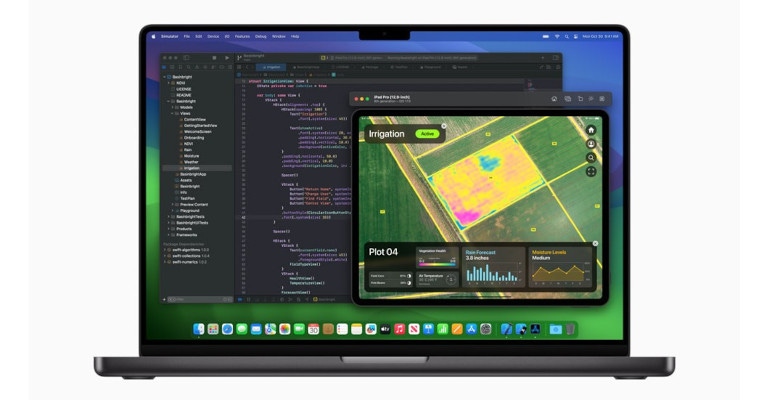Apple Showcases Powerhouse Chips in New Computers
M3 chips supercharge the performance of its latest MacBook Pros and iMacs.

At a Glance
- Apple's M3 chips promise faster performance for data-intensive graphics and programming tasks
While Apple’s annual iPhone introductions are publicized well in advance and ripe with speculation, the introduction of its latest computers, by comparison, tend to be under the radar. Such was the case with Apple announcing several new MacBook Pro and iMac computers.
Apple’s updated MacBook Pro lineup features the all-new family of M3 chips: M3, M3 Pro, and M3 Max. According to Apple, these are the first chips for a personal computer built using industry-leading 3-nanometer technology. The chips use a technology called Dynamic Caching, whereby the GPU allocates the use of local memory in hardware in real time so only the exact amount of memory needed is used for each task. This design reportedly dramatically increases GPU utilization and performance for the most demanding pro apps and games.
Befitting Apple’s traditional strengths with graphics applications, the GPU also brings new rendering features to Apple silicon, including hardware-accelerated mesh shading for greater capability and efficiency with geometry processing, enabling more visually complex scenes. The chips also bring yhardware-accelerated ray tracing comes to the Mac for the first time, enabling games to render more accurate shadows and reflections to create more realistic environments.
The base M3 chip powers Apple’s new 14‑in. MacBook Pro, priced starting at $1,599. According to Apple,the 14‑in. MacBook Pro with M3 is up to 60 percent faster than the 13‑in. MacBook Pro with the older M1 chip. Render performance in Final Cut Pro is up to 7.4x faster than the 13-in. MacBook Pro with Core i7. Code compilation in Xcode is up to 3.7x faster than the 13-in. MacBook Pro with Core i7,3 and up to 40 percent faster than the 13‑in. MacBook Pro with M1.2
The next M3 chip, the M3 Pro, provides even greater performance and additional unified memory support, enabling more demanding workflows for users like coders, creatives, and researchers. Filter and function performance in Adobe Photoshop is up to 3x faster than the fastest Intel-based MacBook Pro,5 and up to 40 percent faster than the 16‑in. MacBook Pro with M1 Pro.4Text-based editing in Adobe Premiere Pro is up to 1.7x faster than the 16-in. Intel-based MacBook Pro,5 and up to 30 percent faster than the 16‑in. MacBook Pro with M1 Pro.4
The flagship M3 chip, M3 Max provides performance and capabilities for those with extreme workflows like machine learning programmers, 3D artists, and video editors. It is up to 2.5x faster than the 16-in. MacBook Pro with M1 Max,6 and up to 11x faster than the fastest Intel-based MacBook Pro model.5 It also supports up to 128GB of unified memory, enabling creators to easily work on large and complex projects spanning multiple pro apps and plugins, or compose huge film scores where entire orchestral libraries are instantly available from memory.
According to Apple, simulation of dynamical systems in MathWorks MATLAB is up to 5.5x faster than the fastest Intel-based MacBook Pro,5 and up to 2x faster than the 16‑in. MacBook Pro with M1 Max.6 Render performance in Maxon Redshift is up to 5.3x faster than the fastest Intel-based MacBook Pro,5 and up to 2.5x faster than the 16‑in. MacBook Pro with M1 Max.6
All MacBook Pro models feature a brilliant Liquid Retina XDR display with 20 percent brighter SDR content, a built-in 1080p camera, an immersive six-speaker sound system, and a wide array of connectivity options. The laptops provide up to 22 hours of battery life.

MacBook Pro with M3 Pro delivers faster filter and function performance in Adobe Photoshop.
Supercharging the iMac
Apple is also deploying the M3 chip in its new 24-in. iMacdesktop computer. According to the company, iMac with M3 is up to 2x faster than the prior generation with M1.1 Compared with an Intel-based iMac, the new iMac is up to 2.5x faster than the most popular 27-in. models,2 and 4x faster than the most powerful 21.5-in. model.3
The 24-in. iMac also features an expansive 4.5K Retina display with 11.3 million pixels and over a billion colors. The computer also now features Wi-Fi 6E, which delivers download speeds that are up to twice as fast as the previous generation, and Bluetooth 5.3, which allows users to connect to the latest Bluetooth accessories. It also features up to four USB‑C ports, including two Thunderbolt ports for superfast data transfer; support for Gigabit Ethernet standard on select models; and up to a 6K display.
Both the new MacPro and iMac computers will be available November 7.
About the Author(s)
You May Also Like



.jpg?width=300&auto=webp&quality=80&disable=upscale)

